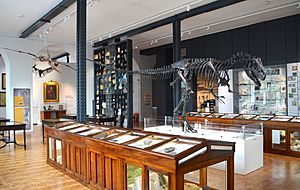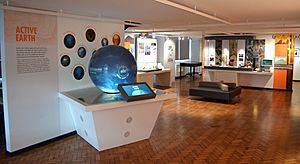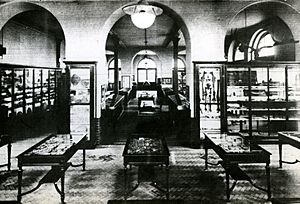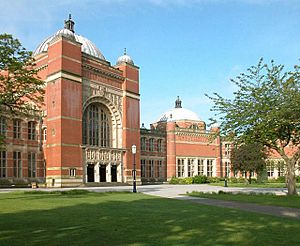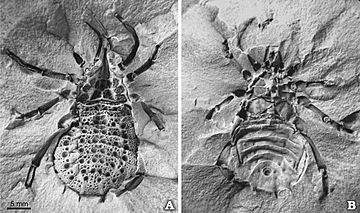Lapworth Museum of Geology facts for kids
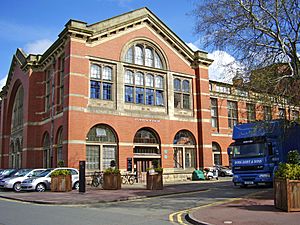
Entrance to the Lapworth Museum
|
|
| Established | 1880 |
|---|---|
| Location | Edgbaston, Birmingham, West Midlands, England |
| Type | Geological museum |
| Visitors | c. 50,000 |
| Public transit access | University railway station |
The Lapworth Museum of Geology is a super cool museum all about geology, which is the study of Earth's rocks, minerals, and history. It's run by the University of Birmingham and you can find it on their campus in Edgbaston, Birmingham, England. The museum is named after a famous geologist called Charles Lapworth. It first started way back in 1880!
The museum got a big makeover and reopened in 2016. They spent a lot of money to create awesome new rooms and displays. They also added modern facilities for visitors and for learning. It's free to visit, which is great! The Lapworth Museum has over 250,000 amazing things in its collection. These include fossils, rocks, and minerals. They are important for science all over the world.
The museum's exhibits tell the story of how life and our planet have changed over 4.5 billion years. It especially focuses on how the environment, climate, plants, and animals in the English Midlands have changed through time. In 2017, the Lapworth was even nominated for a big award called the Art Fund Museum of the Year Award!
Contents
Exploring the Museum's Galleries
The Lapworth Museum has three main areas for visitors to explore. Each one teaches you something new about our planet.
The Evolution of Life Gallery
This is the main hall of the museum. It's called the Evolution of Life gallery. Here, you can see huge replica skeletons of a meat-eating dinosaur called Allosaurus and a flying reptile named Pteranodon. There's also a giant rock wall that goes from the floor to the ceiling. It shows different types of rocks and explains how they change in the rock cycle.
This gallery uses the museum's amazing fossil collection to tell the story of life on Earth. It starts from the very beginning, in the Precambrian time, all the way to today. You can see animated videos that show how the local area of the Midlands changed over millions of years. Imagine tropical reefs in the Silurian Period, swampy rainforests in the Carboniferous Period, or shallow oceans in the Jurassic Period! You can also learn about the Ice Age and how humans have changed over time. There's even a special display about Charles Lapworth himself.
The Active Earth Gallery
In this gallery, you'll learn all about how our Earth works. It explains things like earthquakes, volcanoes, and how climate change happens. You can also discover how huge mountains are formed. There's a cool interactive globe that lets you see how the continents have moved around over millions of years!
The Mineral Wealth Gallery
This gallery is all about minerals. You'll learn how many different kinds there are, how they are dug up, and what we use them for. There are displays about important local people like William Murdoch and Matthew Boulton. You can also see beautiful gemstones and learn about Birmingham's famous Jewellery Quarter. One of the coolest parts is a display of glowing minerals that light up under ultraviolet light!
Visitor Facilities and Learning
The museum has a helpful reception desk, a small shop where you can buy souvenirs, and a cafe for snacks. There are also toilets, and all the galleries are easy to get around for everyone.
There's a special room just for educational sessions. The museum also has a small area for temporary exhibits that change often. If you're a researcher or just really curious, you can ask to see the museum's collections and old documents. The Lapworth Museum also has a great team of volunteers who help out.
History of the Museum
The Lapworth Museum is located inside a beautiful old building called the Aston Webb Building. This building was designed by famous architects Sir Aston Webb and Ingress Bell. It still has many of its original features from the Edwardian era. The museum has been in this spot since the 1920s.
But the museum's story actually began in 1880. That's when Mason Science College was founded, which later became the University of Birmingham. The museum is named after Professor Charles Lapworth. He was the first Professor of Geology at the university. He was also a very important person in geology during the 1800s. The museum's collections have always helped geology students at the university learn. Scientists from all over the world still study these collections today.
The Big Renovation Project
The Lapworth Museum closed in December 2014 for a huge renovation project. It cost £2.7 million! The goal was to completely update and expand the galleries. They wanted to make them more interesting and easier for everyone to enjoy, not just scientists. They also added important things like a proper reception desk, a shop, a cafe, and toilets. They made sure all parts of the museum were easy to access. They also improved the storage for the museum's collections.
Money for this project came from a big grant from the Heritage Lottery Fund. The University of Birmingham's former students and other groups also helped with funding. The museum reopened in June 2016. A famous scientist named Sir Paul Nurse helped open it, along with other important people from the university.
Amazing Collections and Archives
The museum has over 250,000 items! These include fossils, rocks, and minerals. They also have old geological maps, equipment, models, and photographs. You can even find some animal specimens and old stone axes.
The museum also keeps the Lapworth Archive. This is a huge collection of Charles Lapworth's work. It's one of the most complete collections for any geologist from the 1800s. There are also important documents about other geologists like Professor Leonard Johnston Wills and Professor Frederick William Shotton. You can even find information about the Chinese geologist Li Siguang who studied at the university. The archive also highlights pioneering female scientists like Dame Maria Ogilvie Gordon and Dame Ethel Shakespear.
In 2008, the Lapworth's entire collection was officially recognized as being super important for the country and the world. This means its collections are very valuable for scientific research.
Fossil Collections
The museum's fossil collections are especially strong in areas that match the local geology. They also reflect what past and present University of Birmingham scientists have studied. One very important collection is of Silurian marine animals. These are from the 428 million-year-old Wenlock Limestone near Dudley. These fossils show animals that lived in tropical seas when the Midlands was covered by warm, shallow water. Many of these fossils were found in the 1700s and 1800s when people were digging up limestone.
The museum also has a very important collection of graptolites. These are tiny marine creatures that are great for dating rocks. This collection is thanks to Charles Lapworth, who was an expert on them. Other cool collections include plants and animals from the Coal Measures of the South Staffordshire Coalfield. You can also see Ice Age mammals like mammoths and cave bears. There are even incredibly well-preserved fish fossils from places like Brazil and Italy!
Mineral Collections
The Lapworth has about 12,000 minerals from all over the world. It has some especially beautiful examples from mining areas in Cornwall, Cumbria, and Shropshire. Many of these minerals come from collections that are hundreds of years old, from mines that are now closed. A very special collection belonged to William Murdoch. He was a Scottish engineer who worked with James Watt and Matthew Boulton.
Events and Educational Fun
After its renovation, the Lapworth Museum started a new education program. It includes workshops for different age groups, all linked to the National Curriculum. Schools, colleges, and even home-schooling groups use the Lapworth to learn about natural history. You can arrange talks, hands-on sessions, and "behind the scenes" tours for groups.
The museum also started a new annual public talk series. It's called the Keith Palmer Lecture Series. These talks are given by famous speakers and are meant to help everyone understand science better. The first lecture was given in 2017 by Professor Kenneth Lacovara.
The Lapworth also hosts "Lapworth Lectures" every other Monday during term time. These are talks by leading geologists and palaeontologists. You can find a list of speakers and dates on the museum's website.
The museum also takes part in the University of Birmingham's yearly community festival. They have lots of family activities there. The Lapworth also joins in other university events, like the annual Arts & Science Festival. Plus, they organize temporary exhibitions several times a year in their special exhibition space.


